Should you manage these five insects commonly found on coniferous and deciduous trees?
Consider the severity, pest type, and prevalence when deciding on an integrated pest management strategy.

There are many insects that inhabit coniferous or deciduous trees. Some of these pests require management while some of them do not. Can you identify which of these pose problems for nursery or Christmas tree growers?
Webbing on conifers
Not a problem. In this case (see photo), this Norway spruce has many spider webs throughout its branches. These webs were formed by the bowl and doily spider (Frontinella comminus). The spider often lives in colonies and is found in pine woods, shrubs and tall grasses. These spiders do not pose a risk to the plant quality of conifers. Prior to sale, just knock out the webbing and allow the inhabitants to find a new home.
Introduced pine sawfly on white pine
Minor problem. Introduced pine sawfly (Diprion similisis) is a solitary feeder, meaning the insects do not aggregate together to create a severe problem. Therefore, unless there is a heavy infestation of them, chemical management is not required for Christmas tree growers. However, nursery growers may need to treat for this pest in order to meet pest-free shipping requirements for plant inspections.
The preferred host of the introduced pine sawfly is white pine, but they also feed upon Scots, red and Austrian pines. To see the various stages of the lifecycle of an introduced pine sawfly, see the University of Minnesota’s fact sheet, “Introduced pine sawfly.” The first generation of introduced pine sawfly is present in July and the second generation is present in August and September. To differentiate between the various sawfly species such as yellow-headed spruce, larch, redheaded pine, balsam fir sawfly and introduced pine sawfly, see “Time to watch for sawflies on conifers” from Michigan State University Extension.
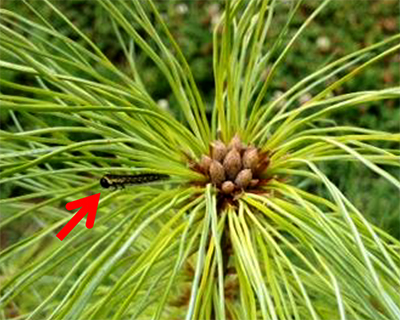
Introduced pine sawfly on white pine. Photo by Heidi Wollaeger, MSU Extension
Cynipid galls on white oak
Minor problem. Typically, the presence of cynipid wasps results in very little plant damage. Nursery growers might need to manage this pest by applying insecticidal treatments. However, insecticides are only effective if applied at the time the wasps are laying their eggs. After an adult female lays her eggs on the plant, the plant reacts by forming a gall, which serves to protect the developing larvae from parasitoid or predator insects and insecticides. For more information on cynipid wasps, visit the fact sheet on “Oak cynipid galls.”
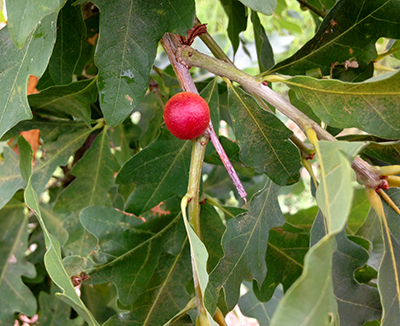
Cynipid galls on white oak. Photo by Heidi Wollaeger, MSU Extension
Lady beetle larvae
Not a problem. Lady beetles are beneficial insects and serve as a predator for many nursery pests, including aphids, spider mites, mealy bugs and scale. These natural predators are working for you!
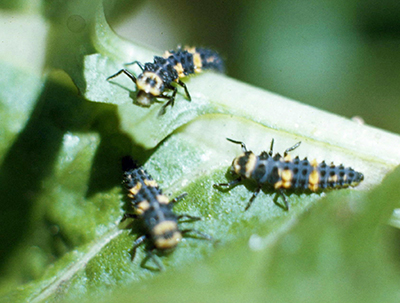
Lady beetle larvae. Photo by Eugene E. Nelson, Bugwood.org
White pine weevil
Moderate problem. The emergence hole (see photo) is created when the white pine weevil larvae emerges during early spring. At this point, growers should prune out the leader, remove from the field and begin to train a new leader by staking it. If damage is heavy enough in the field, growers might consider spraying a registered insecticide. The timing of the spray is critical to its success and should be between 35 and 50 growing degree days. To monitor the growing degree days, check out MSU’s Enviro-weather.
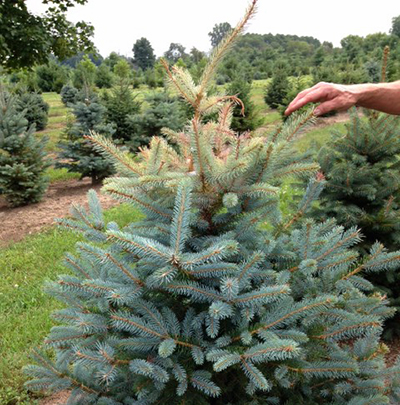
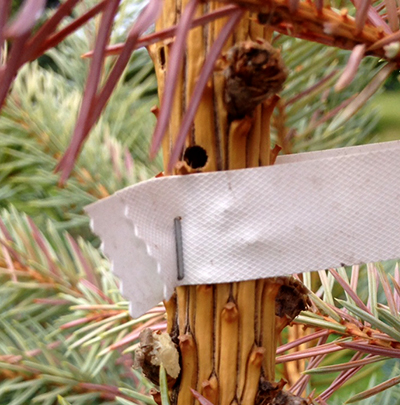
Left, Blue spruce with dying leader. Right, Hole from the white pine weevil. Photos by Heidi Wollaeger, MSU Extension
In summary, certain species of insects are beneficial while others can pose a minor or moderate problem for growers. When deciding on insect management strategies, consider the pests’ severity, its prevalence throughout the field, and potential for future problems. Remember that the Michigan Department of Agriculture and Rural Development has the ability to restrict sale on plants with visible pest or disease symptoms during inspections for nursery stock. While these case studies serve as examples, every situation should be evaluated individually. Contact your local nursery Extension educators for individual consultations.



 Print
Print Email
Email


